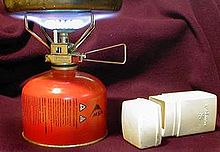Gas cooker
Gas stoves are stoves that burn liquid gas (usually butane , propane or a mixture of both gases) from gas bottles or gas cartridges , thereby generating heat. Gas cookers are easy to use and clean, as gas burns without leaving any residue. In contrast to petrol and kerosene stoves , gas stoves are immediately ready for use, easier to regulate and generally quieter, low-maintenance and almost odor-free. The performance decreases at low temperatures. Butane does not form any flammable gases below its boiling point of −0.5 ° C and can therefore no longer be removed from the gas container. Therefore, on expeditions in cold environments, petrol or petroleum stoves are more likely to be used. Propane has a lower boiling point and can therefore be used at lower temperatures.
history
Gas was first used exclusively for lighting purposes and was then also used for heating and cooking from the mid-19th century. The modern gas cooker go to the so-called gas pans back in the early 19th century, when several German inventor brought out their models. The first gas cookers for domestic use were made in Germany in 1849 by the Austrian engineer RW Elsner in Berlin.
The basis for the first gas cooker was formed by the principle of W. Elsner and the principle of the Bunsen burner , which was introduced by R. Bunsen in Heidelberg.
Before that, the pharmacist Charles Hugueny had already registered a patent for a gas cooker for laboratories and factories in Strasbourg in 1848. Bunsen and Elsner also had their burners patented.
See also
Web links
Individual evidence
- ↑ a b The German cities described based on the results of the first German city exhibition in Dresden in 1903 . F. Brandstetter, 1904, p. 210 ( archive.org [accessed February 23, 2018]).
- ↑ Martin Kornrumpf: "More light ...": Julius Pintsch (1815-1884) and his sons, pioneers of lighting technology . Contribution to the history of the Pintsch works in Fürstenwalde (Spree) 1872–1945. Self-published by the author, 1985 ( google.de [accessed on February 23, 2018]).
- ^ Journal for Chemistry and Physics. Edited by J (ohann) S (alomon) C (hristoph) Schweigger . Schrag, 1857 ( google.de [accessed on February 23, 2018]).
- ^ Ferdinand deep drink: The gas lighting . Schweizerbart, 1874 ( google.de [accessed on February 23, 2018]).
- ↑ Achille Penot: Hugueny's hat for the draft glasses of the gas burners. In: Polytechnisches Journal . 110, 1848, pp. 186-189.
- ↑ Hugueny's hat for the draw glasses of the gas burners. In: Polytechnisches Journal . 110, 1848, p. 288.
- ↑ Emanuel Schreiber: The heating and cooking with gas, both in industrial and in housekeeping: With 77 explanatory figures . Voigt, 1858 ( google.de [accessed on February 23, 2018]).
- ^ RW Elsner: Elsner's new gas burner. In: Polytechnisches Journal . 142, 1856, pp. 210-211.
